Clawfoot Bathtubs
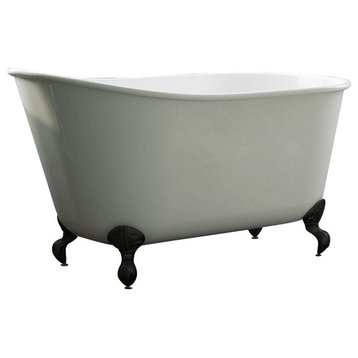
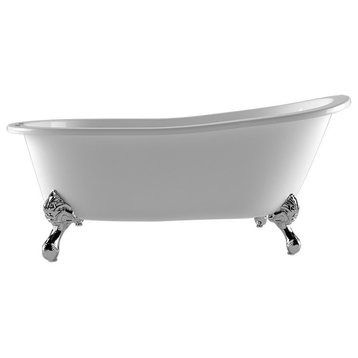
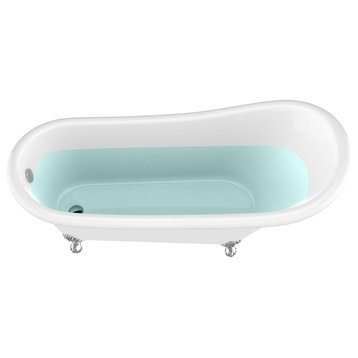
- High-quality acrylic craftsmanship is durable and long-lasting
- Glossy White finish won't dull, crack or fade
- Polished chrome finished Eagle's Talon style claw feet
- Large slipper design allows for luxurious full-body immersion
- Claw feet adjust for easy leveling on any flooring
- Built-in overflow
- Reversible drain
- Exterior dimensions: 67.32"L x 29.53"W x 30.91"H
- Sitting area: 42.52"L x 15.75"W
- Soaking depth: 14"
- 40 gal. capacity
- Lifetime Manufacturer's Warranty
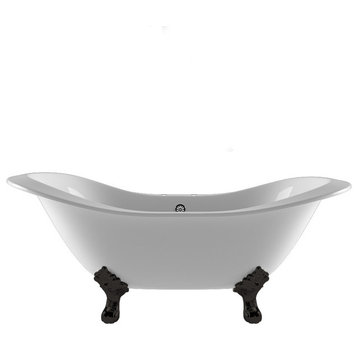
The "Buchanan's" charming contoured ends, sweep up six inches at both ends of the tub and offer the superb hideaway so you can easily enjoy a leisurely soak, from either end of the tub. This tub is a couple's haven and relaxation for two.
The "Buchanan" has amazing Lions Paw feet (offered in numerous finishes) and 44 gallon dual person capability and is the perfect alternative for those searching for relaxation laced in luxury.
To experience the splendor and love of your 71" "Buchanan" saturating bathtub order yours today!
- Cast Iron Double Ended Clawfoot Slipper Tub Design
- Royal Porcelain Interior
- Wonderful Freestanding Tub Design
- Lion's Paw Feet
- Full Manufacturers Warranty
- A full 44 Gallons of Bathtub Water Capacity
- 14 inches to overflow
- Requires Drain & overflow Assembly. Sold Separately
- Top Quality Cast Iron Construction
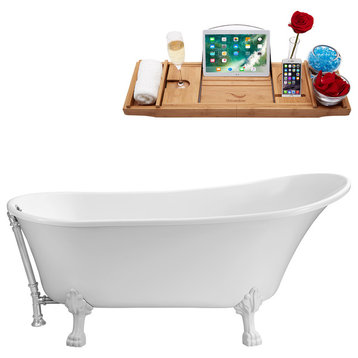
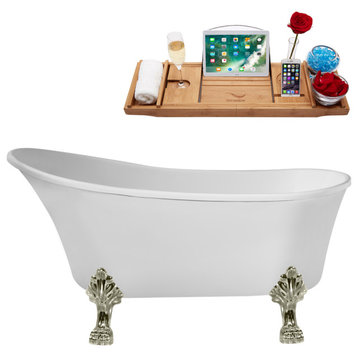
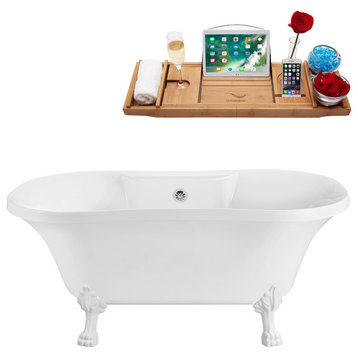
- Overall dimensions: 60" x 32" x 26.4"
- Overall weight: 97.2 LB
- Water Capacity: 53 gallons
- Type and Style: Vintage and Soaking Clawfoot Tub
- Materials: Acrylic, Brass
- Finish: Exterior and Interior - Glossy White
- Overflow drain included
- Claw feet included
- Drain placement: Middle
- External Drain
- Drain finish: Polished Chrome
- Claw feet finish: White
- Deck mount faucet compatible, holes pre-drilled
- 5 Year Limited Manufacturer's Warranty
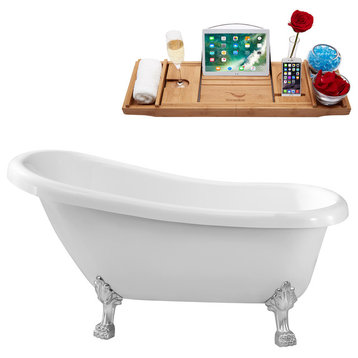
- Overall dimensions: 61" x 27.6" x 31.5"
- Overall weight: 96.8 LB
- Water Capacity: 48 gallons
- Type and Style: Vintage and Soaking Clawfoot Tub
- Materials: Acrylic
- Finish: Exterior and Interior - Glossy White
- Drain included
- Claw feet included
- Drain placement: Right/Left
- Internal Drain
- Drain finish: Polished Chrome
- Claw feet finish: Chrome
- 5 Year Limited Manufacturer's Warranty
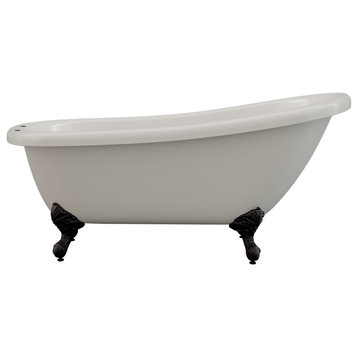
The outside surface of any one of our bath tubs may be customized with the Sherwin Williams paint color of your choosing. The tubs are flawless down to the detailed styles of Clawfeet, that are Imperial Ball & Claw Feet. Whatever tub you decide upon, it will be a perfect addition for your home.
Madison Acrylic Bathtub - Clawfoot Double Ended Tub:
- Acrylic Clawfoot Double Ended Bathtub
- Dimensions: 30" x 70"
- 14 inches to overflow
- Your choice of Claw-Foot set finishes available in Chrome, Brushed Nickel, and Oil Rubbed Bronze
The "Harrison" includes impressive imperial clawfoot feet that are available in several finishes, with a 44 gallons of water capacity for hours of relaxing pleasure. In addition, the high gloss finish is the perfect choice for those looking for relaxation woven with decadent luxury.
This Complete Plumbing Package Includes:
- TTC463D-6 Bullnose Faucet with British Telephone Style Hand Held Shower, and 6" Deck Mount Risers (Mount on Rim of Tub)
- TTC341D Supply Lines Complete with Shutoff Valves and Escutcheons
- TTC1900LTB Modern Lift and Turn Drain & overflow Assembly
- Vintage Tub Dimensions: 28" x 68"
- 13 inches to overflow
- 44 Gallon Capacity
- Available with No Faucet Drillings or with 7" Center Deck Mount Faucet Drillings
- 1 Year Manufacturers Defect Warranty for Tub
- 5 Year Manufacturers Defect Warranty for Plumbing
- Weighs 75 lbs.
The Duchess features a double slipper design which allows for one or two people to relax in modern comfort with the elegance of old world Victorian charm. Because of our unique crafting process you can take pride in knowing that your bathtub is not like any other in the world. Restoria tubs are crafted from an acrylic shell. The shell heats with hot water, and remains hotter for longer than cast-iron tubs. This means your bath stays warmer longer, for a more relaxing, enjoyable experience. The acrylic material is also much cleaner than porcelain, fiberglass, or ceramic surfaces. This means Restoria bathtubs are easier to clean, will hold their shine, and are more resistent to germs and bacteria due to the anti-bacterial acrylic finish. Some acrylic replicas are cheaply made, and experience excessive give when filled with water. Our unique crafting process provides for extra rigidity and horizontal stability. 80 gallons to rim.
- The Duchess measures 68" long with a width of 30". 100% MADE IN USA
- Faucets and Hardware not included
- Dimension: 67 X 33 X 33 inches
- 16 Gauge
- Handmade in Mexico
- Finished in Dark Patina
- Drain 2 inches
- Every Restoria bathtub is 100% Made in the USA.
- 60" Slipper Clawfoot Tub White with Brushed Nickel Feet 7" tub rim faucet drillings
- Because of our unique crafting process you can take pride in knowing that your bathtub is not like any other in the world.
The acrylic material is also much cleaner than porcelain, fiberglass, or ceramic surfaces. This means Restoria bathtubs are easier to clean, will hold their shine, and are more resistent to germs and bacteria due to the anti-bacterial acrylic finish.
Some acrylic replicas are cheaply made, and experience excessive give when filled with water. Our unique crafting process provides for extra rigidity and horizontal stability.
- High gloss acrylic finish on the tub's interior with an orange peel look resin exterior finish that mimics the look of old world cast iron.
- Faucets and Hardware not included
The "Harrison" includes impressive imperial clawfoot feet that are available in several finishes, with a 44 gallons of water capacity for hours of relaxing pleasure. In addition, the high gloss finish is the perfect choice for those looking for relaxation woven with almost decadent luxury. The "Harrison's" exquisite contoured ends sweep up an incredible six inches at both ends of the tub, providing the perfect hideaway to enjoy the leisure of a hot foam bath (from either end of the tub), making this Vintage Styled Acrylic Clawfoot Bathtub the ultimate haven.
Designing your bathroom to include this amazing Acrylic Double Ended Slipper Style Clawfoot Bathtub reveals your taste for both elegance, as well as your credentials in bathroom design. This Complete Plumbing Package Includes:
- TTC684D Gooseneck Faucet with British Telephone Style Hand Held Shower (Mount on Rim of Tub)
- TTC341D Supply Lines Complete with Shutoff Valves and Escutcheons
- TTC1900LTB Modern Lift and Turn Drain & overflow Assembly
- Vintage Tub Dimensions: 28" x 68"
- 13 inches to overflow
- 44 Gallon Capacity
- Available with No Faucet Drillings or with 7" Center Deck Mount Faucet Drillings
- 1 Year Manufacturers Defect Warranty for Tub
- 5 Year Manufacturers Defect Warranty for Plumbing
- Weighs 75 lbs.
- Every Restoria bathtub is 100% Made in the USA.
- 66" Traditional Roll Top Double-ended Clawfoot Tub White with Oil Rubbed Bronze feet 7" tub rim faucet drillings
- Because of our unique crafting process you can take pride in knowing that your bathtub is not like any other in the world.
The acrylic material is also much cleaner than porcelain, fiberglass, or ceramic surfaces. This means Restoria bathtubs are easier to clean, will hold their shine, and are more resistent to germs and bacteria due to the anti-bacterial acrylic finish.
Some acrylic replicas are cheaply made, and experience excessive give when filled with water. Our unique crafting process provides for extra rigidity and horizontal stability.
- High gloss acrylic finish on the tub's interior with an orange peel look resin exterior finish that mimics the look of old world cast iron.
- Faucets and Hardware not included
- Overall dimensions: 60" x 32" x 26.4"
- Overall weight: 97.2 LB
- Water Capacity: 53 gallons
- Type and Style: Vintage and Soaking Clawfoot Tub
- Materials: Acrylic, Brass
- Finish: Exterior and Interior - Glossy White
- Overflow drain included
- Claw feet included
- Drain placement: Middle
- External Drain
- Drain finish: Polished Gold
- Claw feet finish: Chrome
- Deck mount faucet compatible, holes pre-drilled
- 5 Year Limited Manufacturer's Warranty
Drain & overflow, and Supply lines can be cut-to-fit.
- Overall dimensions: 66.9" x 31.5" x 31.5"
- Overall weight: 95.2 LB
- Water Capacity: 69 gallons
- Type and Style: Vintage and Soaking Clawfoot Tub
- Materials: Acrylic, Brass
- Finish: Exterior and Interior - Glossy White
- Overflow drain included
- Claw feet included
- Drain placement: Right/Left
- External Drain
- Drain finish: Polished Gold
- Claw feet finish: Gold
- 5 Year Limited Manufacturer's Warranty
Clawfoot bathtubs exude elegance and a timeless feel. And while most of the draw lies in the classic look that this type of tub gives off, the true convenience is in the flexibility of fixture placement, since there’s typically no need for intrusive changes to walls or flooring. As long as the plumbing can reach the tub, you’re good to go! The deep sides of clawfoot bathtubs make them ideal for a luxury soaking experience that’s sure to help clear your mind.
A Tub Full of History
The clawfoot tub started to gain popularity in the early 19th century, when it was a sign of wealth and social standing. They didn’t require plumbing at the time, and the cast iron held heat to keep the water for longer than any other type of tub. The footings themselves were a statement and have proven to be a timeless feature that continues to withstand centuries of drastic tastes in design. Even with modern amenities and the ability to add built-in bathtubs to your bathroom, the clawfoot style remains in the hearts of design enthusiasts everywhere. However, you don’t need to go scouring antique shops to find the vintage look anymore, as updated versions with the same feel are easy to get your hands on.
Fun Fact: The “clawfoot” is traditionally a ball and claw, with either a lion’s paw or eagle’s talon clutching a ball, although styles have evolved to offer more contemporary options that fit a variety of design tastes.
Know Your Clawfoot Tub Options
All clawfoot bathtubs share the same rolled rim (also called ‘roll top’ or ‘flat rim’) design that adds to its signature look and makes for a smooth transition into and out of the tub. There are a few different style options to choose from, however. You can opt for either a single slipper tub, which is higher on one side for a nice spot to recline and rest your head, or a double slipper tub which has both ends equally elevated to accommodate lounging in either direction (or a two-person soak!). Consider the look and functionality of both to help make your decision.
You’ll also have an abundance of options when it comes to footing finishes and designs (you know, the “claw” part). Since this is purely aesthetic, go with what works best for your overall design style. Think about coordinating or matching your other bathroom fixtures, especially your tub filler. You tub faucet is a particularly important piece to consider before committing to a clawfoot tub. There are three distinct mounting types which may impact your overall design and placement of the entire setup, which you can learn more about below:
- Deck Mounted: The faucet mounts directly to the edge of the bathtub itself. This is a great option if you’re limited on floor space and don’t mind somewhat exposed plumbing.
- Freestanding: The faucet mounts to the floor next to the tub. This style is good if you’re looking to make a statement with the faucet itself and have space to spare around the bathtub.
- Wall Mounted: The faucet mounts to the wall beside the tub. This design works well with limited space and when you want to keep exposed plumbing to a minimum.
Materials Made to Last
Historically, clawfoot bathtubs were made of cast iron because of its scratch-resistant and heat-retaining properties. When coated with porcelain or ceramic enamel, these tubs become smooth and resistant to bacteria, and can also be refinished and restored as needed, which is why there are still so many originals remaining today. The one major drawback to cast iron clawfoot tubs is their weight — don’t even try moving one without professional help! Luckily, updated models made of acrylic or fiberglass are readily available and much, much lighter, making them better suited for placement in second-story bathrooms. It’s also said that acrylic and fiberglass hold heat longer than cast iron, and share the same bacteria-resistant properties. You can’t go wrong with either material, so make your decision based on placement, design and pricing.
Frequently Asked Questions
What is the Best Bathtub Material?
Choosing the right material for your bathtub is crucial for both the aesthetic and functionality of your bathroom. Hereʼs a brief guide:- Durability: Cast iron and acrylic are renowned for their long-lasting qualities.
- Heat Retention: Cast iron and copper keep water warm for longer periods, enhancing your bathing experience.
- Ease of Maintenance: Acrylic and fiberglass are easy to clean and maintain, making them practical choices.
- Aesthetic Appeal: Stone and copper bathtubs add a luxurious touch to any bathroom.
How Wide Should a Bathtub Be? What are the Standard widths?
The width of your bathtub can significantly impact your comfort and the overall spatial dynamics of your bathroom. Standard bathtubs typically range from 29 to 32 inches in width. For those desiring extra space or aiming for a soaking or whirlpool experience, wider tubs of up to 36 inches or more might be preferable. Always ensure that your bathroom layout can accommodate the size of the tub you choose.Can I Replace a Bathtub Without Redoing the Entire Bathroom?
Yes, updating your bathtub does not necessarily mean you have to undertake a full bathroom renovation. Select a tub that fits within the existing space and plumbing configuration to limit the need for extensive modifications. This approach allows for a fresh look and enhanced functionality without the time and expense of a complete remodel.How to Install a Bathtub?
Installing a bathtub is not just about adding a new fixture to your bathroom; itʼs about creating a sanctuary where you can relax and rejuvenate. The process involves preparing the space, aligning the plumbing correctly, setting the tub in place, and sealing it to prevent leaks. Given the complexity, especially with whirlpool or walk-in tubs, we strongly recommend consulting with a professional to ensure a safe and correct installation. Contact professional bathtub installation professionals for expert guidance and peace of mind.How Many Gallons in a Bathtub?
The capacity of a bathtub can greatly influence your bathing experience, affecting everything from the depth of your soak to the amount of water used. On average, a standard bathtub holds between 25 to 45 gallons of water, while larger models like soaking or whirlpool tubs can accommodate up to 80 gallons or more. For the most accurate measurement, always refer to the product details of the specific tub youʼre interested in.





